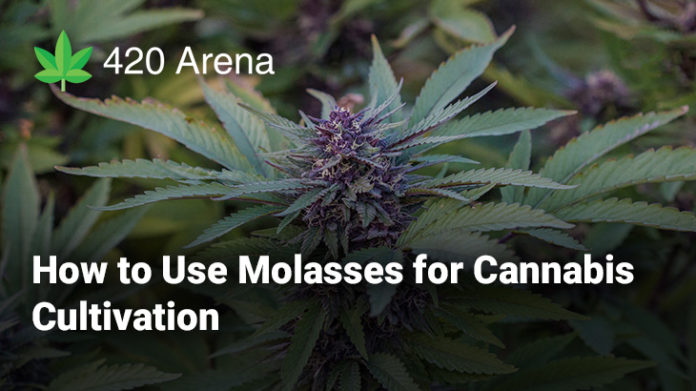Growing marijuana is a fairly simple task. Growing good marijuana is what is actually quite difficult. Practically anyone who follows guidebooks or reads up on basic information can grow a marijuana plant. All it takes is some basic caretaking and the plant grows by itself. However, growing good marijuana is different – growers who follow the best practices know the difference. These growers tend to get bigger yields and can get the maximum possible benefit out of their plants. There are many such tips, tricks, techniques and practices that are to be followed if you are to grow good cannabis. In this article, we shall be talking about one such technique – using molasses for cannabis cultivation.
Growers who know the basics know that they need to provide nutrition to their plants and they can buy these nutrients off the web or in stores near their homes. However, the secret to growing good weed is that you need to go the extra mile – molasses prove to be a great supplement for marijuana plants as they help improve the soil by a great deal! This is a lesser-known secret of the marijuana world and by using this trick you are assured of getting a better quality plant!
Over the course of this article, we shall be taking a closer and detailed look at how to grow better marijuana plants with the help of molasses. We will begin by first talking about what molasses are and what are the benefits of using them. Next, we will be taking a look at how exactly you can use molasses to grow marijuana plants. We will be taking a look at the different kinds of molasses as well. Lastly, we will be answering some frequently asked questions about growing cannabis using molasses before we conclude. Let us begin with the basics:
What are Molasses?
In order to understand how to use molasses for cannabis cultivation, you will need to first know what molasses are! When you boil sugar cane juice or sugar beet juice in the form of a syrup, you will ultimately end up with the sugar crystals. Once the crystals are removed from the solution – the byproduct that remains there is basically molasses. It is very thick and viscous in nature and is dark in colour. There are a number of different uses of molasses – some people tend to use it as a sweetener when it is extracted from sugar cane and others may use portions of it to feed animals when made using beetroot juice.
In some places, especially in the UK, people also refer to molasses as ‘Black Treacle’ so if you hear this term in the markets it is actually molasses which are being referred to. The molasses generated after boiling down sugar cane syrups are usually sweet-tasting while those obtained from boiling beet roots don’t taste as good. Finally, when it comes down to using molasses for cannabis cultivation, you need to make sure you are using only organic products because some of them might contain chemicals which are not so good for the health of your marijuana plant.
Different Types of Molasses
Now that you have a basic idea about what molasses are and how they are made using sugar cane juice and beet root juice syrups, let us take a look at the two broad categories of molasses that exist – sulphured and unsulphured molasses.
Almost all molasses contain natural sulphur in them, but there are some molasses (especially those which are made from sugar cane juice), in which additional sulphur dioxide is added. The presence of sulphur dioxide helps the molasses with its anti microbial properties and it ensures that it remains fresh till the time comes to finally process it further. Basically, the purpose of adding Sulphur Dioxide is to use it as a preservative. However, there is one problem with sulphured molasses – since the addition of Sulphur Dioxide has anti microbial properties, it kills the beneficial microbes present in the molasses and therefore makes it useless for gardening purposes and for cultivating cannabis!
In addition to sulphured and unsulphured molasses, there are other categorizations based on the colour too. As a rule of thumb, people prefer the darker shades of molasses. When you look at it, molasses come in four shades – light molasses, medium or dark molasses, blackstrap molasses (considered the best for our purpose of growing cannabis), and then there’s the darkest of them all – treacle.
Benefits of Using Molasses for Cannabis Cultivation
There are a large number of benefits that molasses offers to growers who are growing plants, especially to those who are growing cannabis. When you are growing weed, the soil that you grow your plants in matters a lot! Sometimes growers tend to overlook this while they focus on the light and the ventilation, but the soil also matters a lot. There are many ways in which you can improve the quality of your soil and adding molasses to it is one of these things. Good soil usually contains Nitrogen, Phosphorus, Potassium in ideal ratios – these are the three main nutrients. In addition to this there are some secondary nutrients such as iron and calcium which also need to be present in the soil.
However, there’s a difference between good soil and great soil. Good soil has all these inorganic substances. Great soil also has a number of organic substances. We are specifically talking about the beneficial microbes that grow in the soil. These microorganisms play a major role in improving the overall health of your soil. Now the question is – how can you promote the growth of these microbes in your soil? By providing them proper food and nourishment. Molasses happens to be the ideal source of food and nourishment for these microbes and it helps them grow stronger and better. Molasses provides these microbes with the carbohydrates and sugars that helps them grow and therefore helps improve your soil.
In addition to feeding the microbes and helping them grow, there are a number of other benefits of molasses as well. First off, they help improve the texture of your soil and also help in improving its water retention capabilities. Molasses also have certain properties which ensure that your soil does not become a breeding ground for pathogens which can later affect your plant’s growth. By improving the water retention of your soil, molasses also help fight against any salt build-up which might be counterproductive for the growth of your plant. In some cases it can also act as a natural insecticide to keep your plants safe from pests.
How to Use Molasses for Cannabis Cultivation
Knowing what molasses are and what benefits they offer to your plant and the soil in which you cultivate your cannabis plants in, let us now take a look at how to use molasses for growing cannabis.
Different growers tend to make use of molasses in different ways for growing weed. Some people prefer to use it as a part of their regular feeding schedule. However, on the other hand there are some people who begin using it as early as when they start preparing their soil for growing weed in it. The best thing about molasses is that they are very flexible to use and you can test it out in any way you want and then go with whatever makes you comfortable.
Personally, we prefer the latter method where molasses are provided to the soil even before the seed has been planted. However, the easiest and the simplest way to provide molasses to your cannabis growing setup is by including them in your watering schedule. Molasses dissolve very well in the water and they can be provided to the soil along with the water that you are pouring on it while watering.
Understanding the dosage of how much molasses should you be mixing along with the water is another tricky thing – remember to not add too much of it! Make sure you are only adding about 1 to 2 tablespoons of molasses in every five liters of water. A pro tip that we have figured out over the years is that when you plan on mixing your molasses in the water that you are going to provide to the plants, make sure that the water is lukewarm. This will help in a quicker mixing process.
Now we stress on adding “the right dose” because if you accidentally add more molasses than you should be, it will begin to show its effect in the long-term growth of your plant and you will notice that burns will begin to emerge on the plant. One last thing that we also need to talk about is the impact of molasses on the ph level of your soil. Sometimes adding these might result in the fluctuation of the ph level and you will need to balance that out.
Pro Tips: Things to Keep in Mind While Using Molasses
Lastly, here are some pro-tips which you must keep in mind while using molasses to grow marijuana.
- Use Only Unsulphured Molasses – This is because the sulphured ones (molasses where Sulphur Dioxide is added for preservation purposes) is not suitable for the microorganisms and might actually cause damage to them instead of feeding them.
- Keep An Eye Out for Animals When Growing Outdoors – Molasses have a scent and a taste that tend to attract some kinds of animals, especially rodents and mud-based life forms which might damage your plants. Be extra cautious about this when growing outdoors.
- Mixing in the Right Dosage – Make sure you’re mixing only about 1 to 2 tablespoons of molasses with every 5 liters of water. Adding extra amounts of molasses might lead to nutrient burns which are undesirable.
- Knowing When to Stop – Lastly, you must know when to stop providing molasses to your plants. The process of providing molasses starts even before the seed is planted but it has to stop about two to three weeks before the harvest begins (just before you start flushing your plant).
Frequently Asked Questions About Molasses for Cannabis Cultivation
Here are the answers to some of the most common and frequently asked questions about using molasses for growing marijuana. We hope that going through these questions will help you understand the use of molasses in an even better manner.
1. Are there any side effects of using molasses?
There are no side-effects as such but sometimes if you add a little too much, especially when growing outdoors, you might attract some unwanted stray animals as they tend to be attracted to molasses.
2. What happens if I add too much molasses to water?
Adding a little too much molasses to water would begin to show its effects during the flowering stage of the plants. This is when you will begin to notice that nutrient burns begin to appear in various places. The thing you need to keep in mind is that you must only add a maximum of two tablespoons of molasses to 5 liters of water. This is the right combination for growers.
3. Will adding molasses to the soil make the bud sweeter?
No, there is no study which proves a relation between adding molasses to the soil and the buds getting sweeter. This is because molasses are used only for the purpose of enrichment of the soil and at no point are they getting absorbed into the plant that you are growing. Most people who have grown cannabis while using molasses to improve the quality of their soil have noticed no significant change in the taste of their bud. This is mostly an urban legend originating from the fact that molasses are a sugar-rich substance.
4. Can molasses act as an insecticide?
People who have used molasses extensively have found that this substance can be used as insecticides and that it is quite effective when it comes to controlling small insects such as aphids, as well as some types of flies and bugs. While there are some small benefits that they offer, we suggest you look for better alternatives and not rely on molasses for protecting your plants from insects.
Conclusion
We hope that this article has helped you answer the question of ‘how to use molasses for cannabis cultivation’ in a comprehensive manner. There are many such additives that you can make use of to improve the condition of your soil and we strongly recommend adding as many organic products as possible which help improve the condition of your soil without proving to be a deterrent of any form. If there are any more questions about using molasses, do let us know in the comments section or drop us a mail about it and we shall get back to you soon! Till then…
Happy Growing! 🙂
Table of Contents

















![How to Use Carbon Filters in Your Grow Room [7 Best Carbon Filters for Grow Rooms in 2021] How to Use Carbon Filters in Your Grow Room](https://420arena.com/wp-content/uploads/2020/12/How-to-Use-Carbon-Filters-in-Your-Grow-Room-218x150.jpg)







![How to Make a DIY Bubble Cloner [Complete Guide] How to Make a DIY Bubble Cloner](https://420arena.com/wp-content/uploads/2021/02/How-to-Make-a-DIY-Bubble-Cloner-218x150.jpg)





